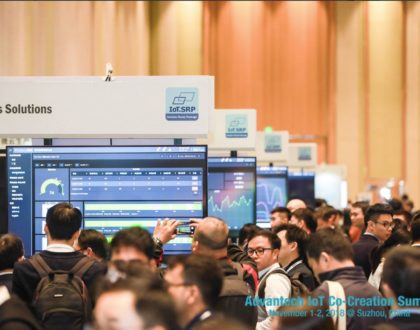Transformation
by Mike Fahrion
 Just a few years ago I gave a number of talks that analyzed ideas first put forward by Gordon E. Moore and Robert Metcalf, and I discussed what would happen when these ideas converged. Moore, a co-founder of Intel, observed that the number of transistors that can be placed inexpensively on an integrated circuit doubles roughly every two years. Metcalfe, often called the “Father of Ethernet,” stated that the value of a network increases proportionally with the square of the number of compatibly communicating devices. It’s tempting to say that as these trends worked in tandem, the inevitable end result could only have been what we are now calling “The Internet of Things”.
Just a few years ago I gave a number of talks that analyzed ideas first put forward by Gordon E. Moore and Robert Metcalf, and I discussed what would happen when these ideas converged. Moore, a co-founder of Intel, observed that the number of transistors that can be placed inexpensively on an integrated circuit doubles roughly every two years. Metcalfe, often called the “Father of Ethernet,” stated that the value of a network increases proportionally with the square of the number of compatibly communicating devices. It’s tempting to say that as these trends worked in tandem, the inevitable end result could only have been what we are now calling “The Internet of Things”.
But looking at it all in my rear view mirror, I know better. Getting this far was a pretty wild ride at times, and it sure didn’t seem inevitable. There were a lot of obstacles along the way, and there were a lot of people who had a vested interest in obstructing the evolution of standards-based data communications. Let me describe the trip the way I saw it.
I joined B&B Electronics as an electrical engineer on the company’s 10th birthday, way back in 1991. This was shortly before the birth of the PC, and B&B’s main focus at the time was on designing and building serial widgets for industry. It was still the Wild West of M2M communications in those days. Everywhere you looked you saw proprietary hardware and protocols, and there was never any guarantee that any two devices would, or could, talk to one another. Our job at B&B was to make all of these machines get along and play nice. We developed one converter after another, we solved one connectivity problem after another, and then we put the new gadgets in our catalog.
As an engineer who was personally involved in designing many of those products, I found myself fielding a lot of telephone calls from engineers who needed help sorting out their connectivity problems. Many of the same questions came up again and again, so I took to writing down what I’d learned and posting it on our fledgling web site. Other B&B engineers did the same, and our site steadily expanded to include a huge library of articles, white papers and application notes. When the search engines came along – with names like Alta Vista, InfoSeek and the Yahoo Directory, we acquired a solid reputation as M2M connectivity experts.
But while the OT (Operations Technology) world was still busy getting machines to talk to each other at all, the IT world was making some astounding progress. Ethernet networking standards were developed and adopted. Cost points fell to amazingly low levels. Ethernet networks and their value grew exponentially, just as Metcalf had predicted.
Over in the operations world people turned up their noses at Ethernet, like it was some smelly gym sock. Hundreds of people told me that we’d never see Ethernet out on plant floors. They said it was too flimsy and too unreliable for real world applications.
Some of that used to be true. But some of it was sheer protectionism. A lot of those automation equipment vendors were – quite understandably — concerned that IT would take over M2M. They dug in their heels and armed themselves with hugely expensive, proprietary standards that were explicitly designed to keep IT vendors from getting anywhere near anybody’s operations department.
But that business model isn’t working anymore. The need for standards, interoperability and reasonable costs is too powerful to be denied. It’s the beginning of the end of the great division between IT and OT, and this trend will have a profound impact on everyone. As far as industrial IoT has come already, we’re still only seeing the tip of the iceberg.
B&B Electronics has been in the connectivity game all along, and so we saw the writing on the wall. We started considering what this new convergence of IT and OT was going to look like, and where B&B would fit in. Clearly, as M2M became standards-based, and as industrial devices became natively interoperable, our special ability to connect the industrial devices of the M2M Wild West would be far less important. We saw a need – and an opportunity – to transform the company.
In addition to our continued focus on connectivity products that facilitate communications across traditional networks, we’ve invested heavily in IT/OT integration and industrial IoT. That’s led to a lot of changes around here.
- We hired a heck of a lot more software engineers. We used to average about one or two software engineers for every hardware engineer.But today’s widgets need to be a lot smarter than their ancestors.They’re not just handing things like media conversion anymore; they’re moving all kinds of decision making functionality out to the network edge.So nowadays our ratio of software engineers to hardware engineers is more like 7 to 1.
- We began developing “intelligence at the edge” technologies, integrating features that reduce system costs and speed up deployment.
- We recognized that IT/OT convergence is much more of a community effort than M2M ever was, so we have established partnerships with key industrial networking players ranging from SeeControl to IBM – partners whose strengths complement our own and will help us provide software platforms and tools to enable large scale industrial IoT solutions.
- Instead of our catalog, we’re working with some savvy distribution partners who know how to put our products in the right hands.
And, just this month, we even updated the company name. We needed a name that would be more in line with what we’re doing and where we’re going. So B&B Electronics has now morphed into B+B SmartWorx.
That doesn’t mean that we won’t support our B&B Electronics products any more. Connecting devices and systems to networks will always be the foundation of our business. We’re still experts at producing rugged, reliable, resilient data communications products, and the knowledge that we gained over the decades will pay dividends. IoT is extending network connectivity to its next logical development. That will call for new products like solutions-enabling media converters, sophisticated IoT network gateways and our new Wzzard ™ industrial IoT sensing platform.
As you can well imagine, we’ve put in a lot of work and a lot of long hours. We’ve got the pizza delivery guy on speed dial. But we’ve produced some of the best work I’ve ever seen from our engineers, and we’ve simultaneously attracted new top talent to the company – people who get it about industrial IoT and want to be where the action is.
But a few things haven’t changed. Metcalf and Moore’s laws will continue to operate, and technology will continue to evolve. Machines will still need to talk to other machines, and we’ll keep finding more ways to make that happen. And, just as I did back in 1991, I’ll still enjoy talking to you about all of it.
Recommended Posts

Co-Creation, Paving the Way to a More Connected Future
November 27, 2018

The Benefits of a ‘Do It For Me’ Mentality in the IIoT
October 5, 2018

Why You Need to ‘Mind the Gap’ in Manufacturing Technology
August 31, 2018
